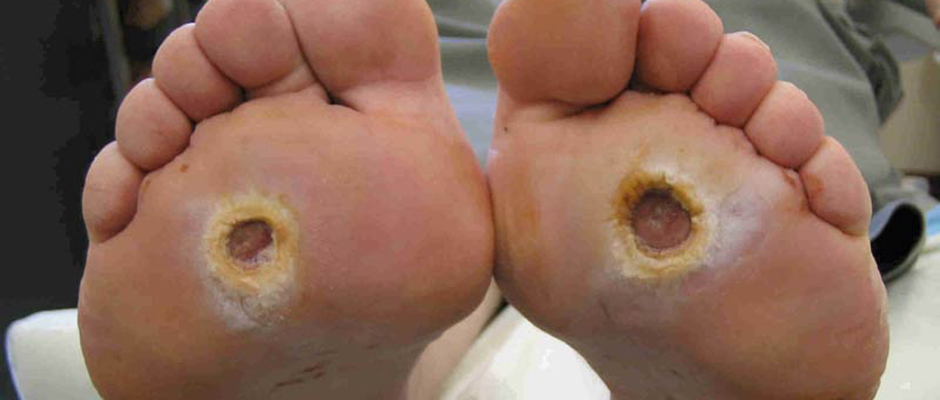Definition of Diabetes: metabolic disorder impairing carbohydrate, protein, and fat metabolism due to insufficient secretion of insulin or tissue insulin resistance.
Medical terminology: Diabetes mellitus

Diabetes can cause many issues for a diabetic’s feet. Mainly nerve and muscle damage (neuropathy) which can leave a patient unable to feel pain in their feet. Often this leads to ulcers in the foot caused from infection that the patient is unaware of due to diabetic peripheral neuropathy.
How does diabetes affect the feet?
[reveal title=”Nerve Damage” open=”false” color=”grey-lite”]Nerve damage in diabetic patients is known as
diabetic peripheral neuropathy and can lead to the loss of protective pain sensation in feet that can lead the patient to be unable to feel foreign objects in shoes, areas of excessive pressure, trauma or infection. This inability to feel pain can cause a host of problems, the main one being infection leading to ulcers.[/reveal][reveal title=”Muscle Damage” open=”false” color=”grey-lite”]Muscle damage in diabetic patients is known as
motor neuropathy and can lead to the a patient’s inability to maintain their balance, diminished or lack of reflexes, muscle weakness and loss of muscle tone. Often muscle neuropathy presents itself in the feet with clawed toes due to muscle loss in the toes.[/reveal][reveal title=”Increase Probability of Infection” open=”false” color=”grey-lite”]Diabetic patients often have in increased chance of infections due to their inability to feel pain in their feet. This is caused in diabetics due to high blood glucose levels which affects the body’s ability to handle infectious agents, additionally, bacteria use glucose for energy to reproduce![/reveal][reveal title=”Skin Changes” open=”false” color=”grey-lite”]Diabetic patients often suffer from dry, cracked skin, excessive sweating, corns and/or calluses, ingrown toenails and skin ulcers. Diabetic patients are more susceptible to pressure
ulcers due to neuropathy allowing an infection to develop since person does not feel pain in the infected areas, and often the infection goes untreated. Regular visits with David Allison can ensure that diabetic patients prevent possible infections, or get immediate help in treating the infections before they before ulcers.[/reveal][divider_line type=”divider_line”]
[list style=”arrow” color=”blue”]
- Cutting straight across
- Do not leave spikes at the edges of nail
- Do not cut too short
- If cannot perform own nail care, contact David Allison for an appointment
[/list]
[list style=”arrow” color=”blue”]
- Deep, wide toe box, 0.5 cm from longest toe
- rigid heel counter
- no seams, no friction points inside the shoe
[/list]
[list style=”arrow” color=”blue”]
- White socks allow you to inspect to see if there is any bleeding
- Cotton socks or another breathable material
[/list]
[list style=”arrow” color=”blue”]
- Check top of foot, bottom of foot
- Check in-between toes for peeling skin or cuts
- Check socks for bleeding
- Check shoes for foreign objects
[/list]
[divider_line type=”divider_line”]
Diabetic Foot Care Don’ts
Self-treating any foot ailment, including corns, calluses or ingrown nails can lead to potential infections, which can lead to foot ulcers. Diabetic patients must be diligent in not self-treating, as sever ulcers can lead to loss of toes and feet. Contact David Allison to help with help for treating any of your overall foot ailments and diabetes related foot treatment.
Wearing tight socks, ill-fitting shoes or tight clothing which can restrict blood flow to your feet.
DO NOT go barefoot, always wear shoes indoors and outdoors! Going barefoot can lead to diabetic patients injuring their feet and not knowing it, if they have diabetic peripheral neuropathy. Without the sensation of pain, injury is likely to occur when going barefoot. Shoes indoors and outdoors is the best way to ensure your feet are safe!
DO NOT ignore leg pain, seek care immediately. Leg pain can be an indicator that something more serious, like infection, is occurring. Diabetes can lead to poor circulation, and peripheral neuropathy, therefore leg pain can be an indicator of major infection in the feet for example. See a doctor immediately if you feel leg pain!

